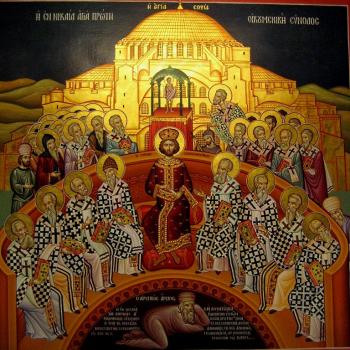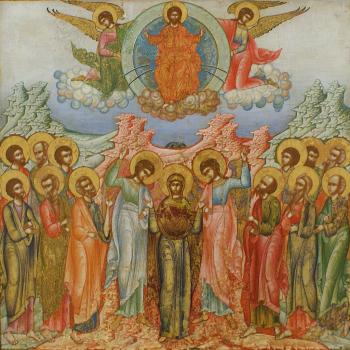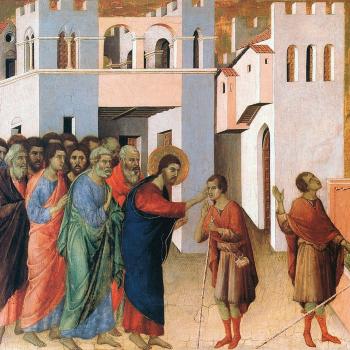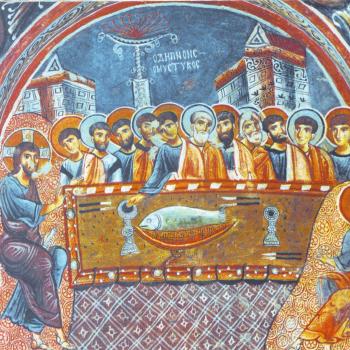From time to time in history we find a consistent, though far from universal, misapplication of the creation story in Genesis led to the belief that women were made ontologically inferior to men because of how they were created:
So the LORD God caused a deep sleep to fall upon the man, and while he slept took one of his ribs and closed up its place with flesh; and the rib which the LORD God had taken from the man he made into a woman and brought her to the man. Then the man said, “This at last is bone of my bones and flesh of my flesh; she shall be called Woman, because she was taken out of Man.” (Gen. 2:21-23 RSV).
Because she came out of Adam, that she was said to be made from a small part of him, some thought this indicated that Eve was made to be Adam’s inferior. To some, a woman is just a defective man. But to interpret this text as indicating Eve was inferior to Adam, and therefore, that women are inferior to men, is to do the text an injustice. Eve was made to be Adam’s equal, not his inferior. For God’s intent was to make someone who was fit for Adam, that is, someone who could complement him as an equal. “Then the LORD God said, ‘It is not good that the man should be alone; I will make him a helper fit for him’” (Gen. 2: 18 RSV). Eve was made to share with Adam the divine image which was given to humanity, so that, just like the persons of the Trinity, Adam and Eve can come together and form a community of love, as St. Edith Stein understood:
It is not a question here of a sovereignty of man over woman. She is named as companion and helpmate, and it is said of man that he will cling to her and that both are to become one flesh. This signifies that we are to consider the life of the initial human pair as the most intimate community of love, that their faculties were in perfect harmony as within a single being; likewise, before the Fall, all faculties in each individual were in perfect harmony, senses and spirit in right relation with no possibility of conflict.[1]
Eve, representative of all women, was Adam’s companion, not his servant. There was no implied lordship of Adam over Eve due to the way she was generated. They were created as equals, expected to be united together in perfect harmony, representing together the image and likeness of God. “So God created man in his own image, in the image of God he created him; male and female he created them” (Gen. 1:27 RSV).
Adam and Eve both were made in the image and likeness of God. For this reason, the Venerable Bede was emphatic in his declaration of her Eve’s equality with Adam, that women equally found the image and likeness of God within them as did men:
For the female also was created in the image of God, on the account of the fact that she too had a rational mind. But Scripture did not consider that this needed to be added about her, because it left this to be understood about her as well on the account of the oneness of their union. Indeed, it signified that this was to be understood about the entire human race which was born from them.[2]
Eve was no different, ontologically, from Adam. Gender difference is not meant to be seen as a substantial divide. They were equal, and equally, both of them found God’s image stamped upon them, giving them a high level of dignity which must not be denied either of them. And together, they also unite, to represent the image and likeness of God. This is because humanity, made in the image and likeness of God, finds itself analogous to the Trinity. When talking about each divine person, we note they are God, fully God, not a part of God, but all that God is. And yet when we talk about the three persons, we do not then establish three Gods but we have still the one and same God, for there is nothing which substantially divides the persons to create three Gods.
Moreover, when we reflect upon the logical order of the persons in the Trinity, we can better understand why, when we see Adam preceded Eve, this does not mean he is ontologically superior to her. For we find in the Trinity that the Father is logically the “first person” of the Trinity, who logically, but not substantially, precedes the Son and the Spirit. For the Father beget the Son and the Spirit proceeds from the Father and through the Son. This is not to suggest that the Son or Spirit are created or temporally after the Father, but only in their eternal relationships, the Father is said to be unorginate while the other two persons have their eternal origin in and from the Father. Logical precedence must not be understood as ontological priority.
The confusion of logical with real distinction is what led to subordinationism within the Trinity, believing that the Son and the Holy Spirit are inferior to the Father. This logic, moreover, is what lies behind the belief that Eve is inferior to Adam because of his accident in time preceding her origin. What we must understand is that there are differing relations between the persons of the Trinity which establish a logical, not real, distinction, based upon the “monarchy” of the Father, where the Father is unoriginated, the Son is begotten of the Father, and the Holy Spirit proceeds from the Father and through the Son. The monarchy of the Father is not an ontological status, but a logical one. Every time relations were turned into substantial divisions, heresies emerged, among the first and greatest of them being the Arian heresy.
To confront the Arians, Christian leaders had to demonstrate the kinds of errors which emerged once such subordinationism was accepted and led to a rejection of consubstantial nature of the persons of the Trinity. If we call the Father, Father, then for the Father to be Father without change he would have to be Father in all eternity. This meant there will have to be an eternal Son, less the Father is said to change, which would undermine our belief in his divinity (for God does not change). Thus, Niceta of Remesiana explained:
And so you believe in God the Father almighty – an unbegotten God, because He had no origin or beginning outside Himself; an invisible God, whom no bodily eye is able to look upon; an incomprehensible God, who comprehends all else; an immutable God, who does not change with time nor age with years but ever remains the same, who never began nor will ever cease to live, nor will ever be succeeded by another; a good and just God, the creator of heaven and earth. You confess Him as God, but you likewise confess Him as Father, and therefore, the Father of His Son, since no father is father unless he have a son. He is the Father by reason of the Son, having, of course, a Son of whom He is the Father. [3]
If there is a time the Father was not the Father, then he has changed, but since he is Father from all eternity, he has eternally begotten the Son, who is all that he is in nature, and therefore equally God with the Father. The Father, while logically prior to the Son, is not greater than the Son, for the Father and Son are God, with all that God is, is found in the Father and in the Son. Likewise, the Spirit who proceeds from the Father and through the Son is God, while logically and personally distinct from the Father and the Son, is also God from God, fully God, equal to the Father and the Son despite being logically posterior to them. St. Bonaventure explained this internal relationship and equality of the persons of the Trinity in his Breviloquium by telling us:
Faith directs that we hold this about the plurality of the persons: in the unity of nature there are three persons, the Father, the Son and the Holy Ghost. Of these the first proceeds from nothing, the second from the first alone through generation, and the third from the first and second by spiration or procession. Thus the Trinity of persons does not exclude from the divine essence perfect unity, simplicity, immensity, eternity, immutability, necessity, and even primacy, but rather the more includes perfect fecundity, love, liberality, equality, interrelationship, likeness, and inseparability. [4]
The logical distinctions which allow for personal relations between the Father, Son and Holy Spirit, is therefore evident in humanity, stamping humanity with a similar feature, where the persons are distinct but meant to be equal. Eve might come from Adam, but she is no inferior of Adam; she is equally human, equally in the image of God. Personally, she is distinct, but ontologically she is Adam’s equal. Nothing in their distinctions establish one as superior or inferior to the other.
![Satan Watching the Caresses of Adam and Eve by William Blake via Wikimedia Commons [Public Domain]](https://wp-media.patheos.com/blogs/sites/637/2016/07/Blake_William_English_1757%E2%80%931827_Satan_Watching_the_Caresses_of_Adam_and_Eve_Illustration_to_Paradise_Lost_1808_pen_watercolor_on_paper_50.5_x_38_cm_Museum_of_Fine_Arts_Boston_US-229x300.jpg)
Sin has used logical distinctions to divide and establish ontological barriers. To us, what we consider to be natural, and reflect upon in our phenomenologies, represents not what is natural but the way nature is perceived as a result of the fall. We divide people from each other, and do not see their ontological equality, because sin has corrupted them and made them unequal. This is why subordinationism is an easy trap for us to fall into, because it follows with and through the logic of division established by sin. We have problems understanding the relationship between persons and nature and so divide up the nature through the division created between persons through sin. Then, because we cannot see the unity in humanity, we then think of divine persons similarly, dividing up the divinity, leading some to the conclusion that only the Father can be the true God because of his logical priority.
We can say that the attempt to divide humanity into distinct parts, with some greater than others based upon differences of gender, race, or the like, creates an individualization which has ramifications for the divine nature and explains why so many misconstrue the Trinity as either Tritheism or three parts of a whole. But this is exactly what sin tries to do, using logical distinction to create actual division, creating through it, superiors and inferiors which should not exist, and naturally, do not exist. Any attempt to establish a superior race or gender is the result of generalization based upon this radical change as a result of the fall, creating false universals to fight against each other.
In Jesus, in the re-establishment of perfect humanity, all such divisions are to be overcome, leading to the elimination of all such false universals in the new, perfected humanity. Logical distinctions, just as the distinction between Son and Spirit, remain, so that male and female remain, but not as a way to overturn the unity of humanity but as a way to reflect it even as the persons of the Trinity reflect the one, simple nature of the divinity. And so in the new humanity established by Jesus, all such divisions which divide the nature are removed, allowing Paul to say, “There is neither Jew nor Greek, there is neither slave nor free, there is neither male nor female; for you are all one in Christ Jesus” (Gal. 3:28 RSV). Paul was not saying there is no logical distinctions, and so there are no genders (as his discussion of gender in other places indicate) but rather, the attempt to construct divisions in humanity based upon such distinction is overcome as all find themselves together as one in Jesus.
In restoring humanity, Jesus healed the divisions brought into nature as a result of sin, so that in the new creation, in the eschatological kingdom, they no longer exist. The results of the fall are reversed, and with it, the subordinationism which would divide nature against itself is rejected. All the cracks in nature which sin established have been healed over. Among the first things healed by Jesus was the division established by the fall which separated the genders, as St. Maximus the Confessor wrote:
Thus He united, first of all, ourselves in Himself through the removal of the difference between male and female, and instead of men and women, in whom this mode of division is especially evident, He showed us as properly and truly to be simply human beings, thoroughly formed according to Him, bearing His image intact and completely unadulterated, touched in no way by any marks of corruption.[5]
In this way Jesus restored in himself, the integral equality of each gender, allowing them to truly come together as one in love. What was intended for humanity, with the loving unity and equality between Adam and Eve, has been restored by him so that there is to be neither male nor female creating an ontological divide which seeks to place gender as inferior to the other. Any attempt to do so is done in and through the lens of the sin, the lens of the fall, and is fundamentally a rejection of the restorative work done by Christ, and this must no longer be allowed. Nothing, therefore, must remain of the gender division of humanity, less in propping it up, we fall once again to the errors of the past and find ourselves perishing in the indignity established by sin.
[1] St. Edith Stein, “Vocations of Man and Woman” in Collected Works. Volume 2. Woman. trans. Freda Mary Oben, Ph.D. (Washington, DC: ICS Publications, 1996), 62.
[2] St. Bede, On Genesis. trans. Calvin B. Kendall (Liverpool: Liverpool University Press, 2008), 92-3.
[3] Niceta of Remesiana, “An Explanation of the Creed” in The Fathers of the Church. A New Translation. Volume 7. Niceta of Remesiana. Sulpicius Severus. Vincent of Lerins. Prosper of Aquitaine. trans. Gerald G. Walsh, S.J., Bernard M. Peebles, Rudolph E. Morris and J. Reginald O’Donnell, C.S.R. (New York: Fathers of the Church, Inc., 1949). 44.
[4] St. Bonaventure, The Breviloquium. trans. Erwin Esser Nemmers (St. Louis, Mo.: B. Herder Bok Co., 1946),25.
[5] St. Maximus the Confessor, “Ambiguum 41” in On Difficulties in the Church Fathers. The Ambigua. Volume II. trans. Nicholas Constas (Cambridge: Harvard University Press, 2014),115.
Stay in touch! Like A Little Bit of Nothing on Facebook:
A Little Bit of Nothing












